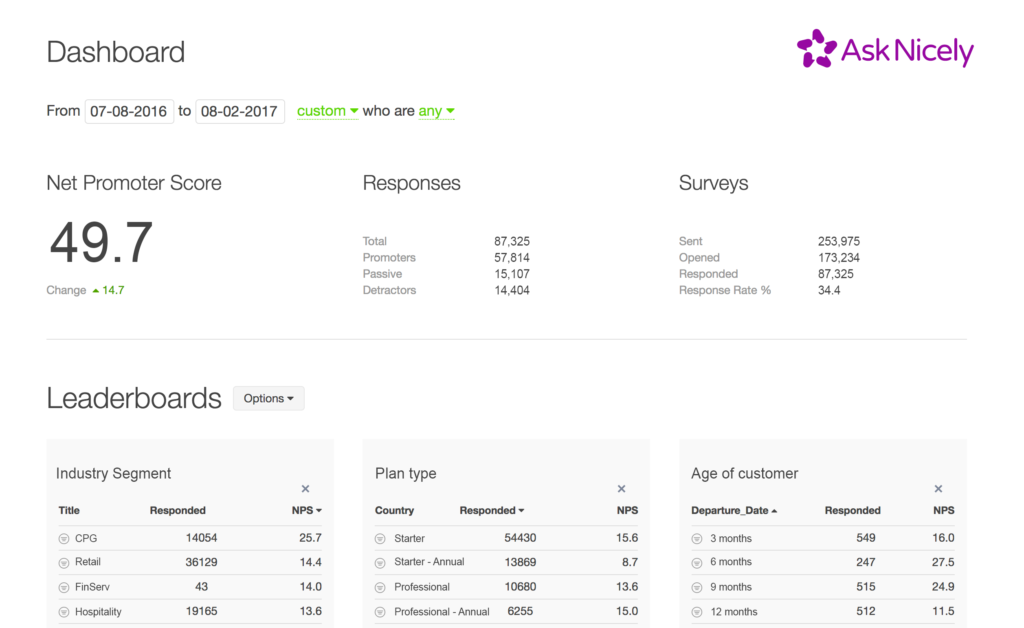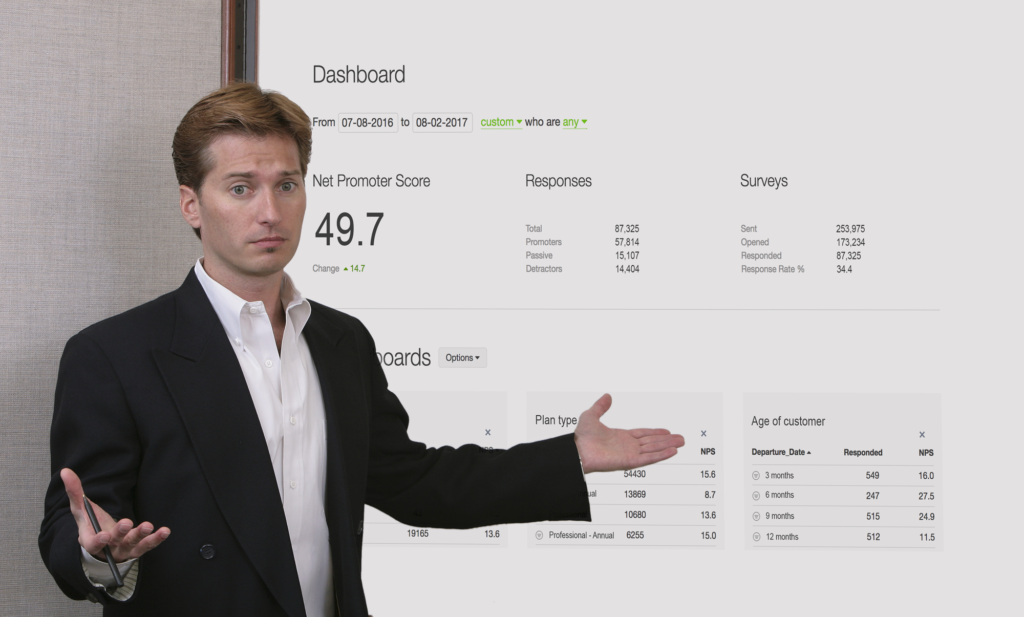By Aaron Ward, CEO and Co-founder AskNicely
You have finally got a pitch meeting with investors. They stare over the table at you, and ask “So, how do we know you can keep the revenue coming in?”
You are prepared with all your figures for the last four quarters, your costs, revenue breakdowns, market sizes. In the second after they ask, you realise. It’s all retrospective. It says what you did, it doesn’t (and can’t) give any guarantees about the future. Cause you can’t tell the future, right?
Unless you can.
A well-structured NPS programme gives you that ability. At any moment, you can see how your customers are feeling about your product, your service, and what they are doing to help your company succeed. Two simple questions, well tested over more than a decade, help you understand your customers without burdening them with long tedious surveys.
The Survey
The first NPS question, “How likely are you to recommend *company name* to a friend or family member?” immediately makes the customer consider if they will align their values and reputation with your brand. Is this the type of company I’d stake my reputation against? Would I want my mother getting this kind of service?
The second question “What is the reason for your score?” allows the customer to let you know, in their own words, what the most important event or interaction was that drove their rating of you.
This real-time data gathering shows how your customers feel right now, which areas of your business are performing, and which need guidance. You don’t have to wait for the end of each quarter to find out who is helping and who is hurting; the message comes directly from the customer to you.
NPS link to revenue
Projecting revenue needs to be based on a solid understanding of your customers. Revenue is the outcome of a purchasing decision and as they have always been, purchasing decisions are driven partly by fact and partly by emotion.
The difference today is the emotional side is sitting much closer to the facts. Your potential customers want to hear from your current customers and know that they aren’t going to be forgotten as soon as the payment is made. The glitz of marketing is less impactful than ever, especially on Millennial audiences, who are turning to their peers and reviews to understand the reality of dealing with your brand.
Using NPS to identify your advocates and promoters gives you access to the most powerful tool in marketing – word of mouth. People are looking for advice and stories from others who they can relate to; that might be in the same line of business, facing the same problems, or with the same demographics.
It’s the same strategy Apple used to grow its desktop computer market in the 1980’s. By focussing on the school and small business markets left open by otherwise incumbent IBM, Apple was able to grow a significant and consistent following as they became ‘the brand to buy’ in those markets. Teachers and principals spoke to other teachers and principals about what to buy, and Apple quickly cornered the market.
By focusing on your NPS, you are focusing on your customers. By focusing on your customers, you are focusing on your revenue.
This enables you to build a company where your customers sell for you. Your business needs to be able to rely on your customers to generate referrals which you can then turn into new customers. Your NPS survey allows you to measure how effectively your customers are doing that, and which markets and areas of the business you can focus on to generate more promotors.
All of which gives you a great answer to where your future revenue is coming from.
NPS link to investment
Your investors are giving you money are looking for a return. They are trusting the business you are building is a revenue generating engine, and you have sufficient control over the mechanics to ensure their investment will grow over time. With their investment, you must be able to boost the engine – and increase the revenue coming out the back.
Business owners don’t think about their business in the way that investors do. They must contend with finding staff and keeping them happy, ensure cultural fit, constantly checking the market for competitors and new opportunities.
Savvy investors understand the power of NPS and its contribution to revenue. In demonstrating your commitment to NPS, you show your ability listen to customers and to build their views into your product cycle.
This builds trust between you and your customers, reinforcing the relationship that encourages them to become your ambassadors.
NPS and Millennials
Once your NPS system is embedded in your business, NPS data becomes a lead indicator for revenue. The happier your customers are, the more likely they are to recommend you – a critical part of your sales methodology as Millennial purchasing power continues to increase.
Millennials are more likely than any other generation to seek out and rely on word-of-mouth (WOM) to inform their purchasing decisions.
50% of Millennials rely on WOM, as compared with 42% of Gen X, and 33% of Baby Boomers. Millennials are also more likely to research your product through online reviews, with 78% saying they have used online reviews (compared with 72% and 62% for Gen X and Boomers respectively). (data from SalesForce.com)
As Daniel Newman writes on Forbes: “they don’t want it from a brand, necessarily – they want it from trusted sources – and who’s more trusted than their own social communities”.
The customers who write positive reviews for you are a subset of those who are recommending you to their friends. And all of those need to have a positive experience before they can tell people about it. Which leads us to experience improvement.
NPS and experience improvement
One of the keys to improving your NPS is realising that NPS is just the measure. What you do with the feedback is equally (if not more) important than the measure itself.
NPS is a short survey. It’s low effort for customers to complete, which increases response rates. Higher response rates mean more data points for analysis, providing a more granular view of which parts of your business are driving the experiences you want and which are not.
By taking that data and understanding the processes or experiences which are causing low scores, you can quickly and effectively target which areas have room for improvement. This provides a quantifiable measure and safeguards you against the political nature of process improvement (shifting of blame between units), and helps hold your teams accountable for their contribution to your service experience.
Link NPS feedback to other customer data to identify strong and weak areas in your business, then use that insight to guide further analysis.
Conclusion
NPS is a marker which allows you to objectively assess how your customers are feeling about your product and their experiences with your company. Used well, that information can not only help you to understand and predict churn rates and revenue, it provides you insights into your customers, new markets, and high-impact improvements.
You have finally got a pitch meeting with investors. They stare over the table at you, and ask, “So, how do we know you can keep the revenue coming in?”
You smile. “Let me show you our NPS numbers, and tell you how they mean money.”
Aaron Ward
CEO and Co-founder AskNicely
AskNicely helps businesses increase customer retention, spend, reviews and referrals by making NPS® part of the daily mission for everyone in the company. Integrate AskNicely’s real-time NPS with your favourite apps to collect feedback at critical moments and empower everyone from front line reps to the C-suite to act on customer feedback every day.







